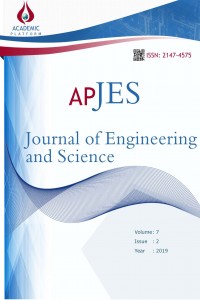Abstract
This paper deals with the mechanical performances of glass fiber reinforced cementitious composites made with industrial
punching scrap. Two types of scraps with diameters of 5 mm and 7 mm were used in the production of cementitious
composite. The glass fibers were added at the ratio of 3 % by weight, and scrap were mixed with the weight ratios of 1%, 1.5%
and 2%. Pressure, flexural strength, and shrinkage tests were carried out on the produced samples. In addition, freezing and
thawing effects were also investigated. According to the results of the study, it was found that using scrap 1.5% by weight
improves the properties of the pressure and flexural strength properties of the composites. It was also observed that using scrap
2% by weight waste reduces the effects, when the shrinkage behavior was examined.
References
- [1] Bentur, A., and S. Mindess. Fibre reinforced cementitious composites. CRC Press, 2014.
- [2] Halpin, J. C. Primer on Composite Materials Analysis, (Revised). Routledge, 2017.
- [3] Kasagani, H., and C. B. K. Rao. "Effect of graded fibers on stress strain behaviour of Glass Fiber Reinforced Concrete in tension." Construction and Building Materials 183 (2018): 592-604.
- [4] Betterman, L. R., C. Ouyang, and S. P. Shah. "Fiber-matrix interaction in microfiber-reinforced mortar." Advanced Cement Based Materials 2.2 (1995): 53-61.
- [5] Song, P. S., and S. Hwang. "Mechanical properties of high-strength steel fiber-reinforced concrete." Construction and Building Materials 18.9 (2004): 669-673.
- [6] Neville,A.M., Brooks, J.J., (1987) Concrete Technology Longman Scientific and Technical, p.285.
- [7] Dehghan, A., Karl P., and A. Shvarzman. Recycled glass fiber reinforced polymer additions to Portland cement concrete. Construction and Building Materials 146, 2017: 238-250.
- [8] Sathanandam, T., Low carbon building: Experimental insight on the use of fly ash and glass fibre for making geopolymer concrete. Sustainable Environment Research 27.3 (2017): 146-153.
- [9] Mastali, M., A. Dalvand, and A. R. Sattarifard. The impact resistance and mechanical properties of reinforced self-compacting concrete with recycled glass fibre reinforced polymers. Journal of Cleaner Production, 124 2016: 312-324.
- [10] Vijayalakshmi, M., and A. S. S. Sekar. Strength and durability properties of concrete made with granite industry waste. Construction and Building Materials 46, 2013: 1-7.
- [11] Marcondes, P.V.D., Eto, A.M., P.A.C. Beltrǎo, P.C. Borges, A smart stamping tool for punching and broaching combination, Journal of Materials Processing Technology,206(2008) 184–193.
- [12] Hatanaka N., Yamaguchi K., Takakura N. and Iizuka T. Simulation of sheared edge formation process in blanking of sheet metals, Journal of Materials Processing Technology, 140,2003: 628–634.
- [13] Myint, M. H. Evaluation of wear mechanisms of Y-TZP and tungsten carbide punches." Journal of Materials Processing Technology 140.1-3,2003: 460-464.
- [14] Gang F., Zeng P., and Lou, L. Finite element simulation of the effect of clearance on the forming quality in the blanking process. Journal of Materials Processing Technology 122.2-3, 2002: 249-254.
Endüstriyel Delme Artığı ile Üretilmiş Cam Elyaf Takviyeli Çimento Bazlı Kompozitlerin Mekanik Özellikleri
Abstract
Bu çalışmada endüstriyel delme artıkları ile üretilmiş cam elyaf takviyeli betonların mekanik performansı ele alınmıştır.
Çapları 5 mm ve 7 mm olan iki tür zımba ile delme artığı kompozit üretiminde kullanılmıştır. Cam elyaflar ağırlıkça %3
olarak, delme artıkları ise yine ağırlıkça %1, %1,5 ve %2 olarak kompozit karışımlarına eklenmiştir. Üretilen numuneler
üzerinde basınç, çekme dayanımları ve büzülme testleri gerçekleştirilmiştir. Ayrıca, donma ve çözünme etkisi de incelenmiştir.
Çalışma sonuçlarına göre zımba ile delme artığının ağırlıkça %1,5 oranında kullanılmasının kompozitlerin basınç ve çekme
gerilmeleri özelliklerini iyileştirdiği ortaya çıkmıştır. Büzülme davranışı incelendiğinde ise ağırlıkça %2 oranında delme artığı
kullanılmasının bu davranış altındaki etkileri azalttığı görüşmüştür.
Keywords
References
- [1] Bentur, A., and S. Mindess. Fibre reinforced cementitious composites. CRC Press, 2014.
- [2] Halpin, J. C. Primer on Composite Materials Analysis, (Revised). Routledge, 2017.
- [3] Kasagani, H., and C. B. K. Rao. "Effect of graded fibers on stress strain behaviour of Glass Fiber Reinforced Concrete in tension." Construction and Building Materials 183 (2018): 592-604.
- [4] Betterman, L. R., C. Ouyang, and S. P. Shah. "Fiber-matrix interaction in microfiber-reinforced mortar." Advanced Cement Based Materials 2.2 (1995): 53-61.
- [5] Song, P. S., and S. Hwang. "Mechanical properties of high-strength steel fiber-reinforced concrete." Construction and Building Materials 18.9 (2004): 669-673.
- [6] Neville,A.M., Brooks, J.J., (1987) Concrete Technology Longman Scientific and Technical, p.285.
- [7] Dehghan, A., Karl P., and A. Shvarzman. Recycled glass fiber reinforced polymer additions to Portland cement concrete. Construction and Building Materials 146, 2017: 238-250.
- [8] Sathanandam, T., Low carbon building: Experimental insight on the use of fly ash and glass fibre for making geopolymer concrete. Sustainable Environment Research 27.3 (2017): 146-153.
- [9] Mastali, M., A. Dalvand, and A. R. Sattarifard. The impact resistance and mechanical properties of reinforced self-compacting concrete with recycled glass fibre reinforced polymers. Journal of Cleaner Production, 124 2016: 312-324.
- [10] Vijayalakshmi, M., and A. S. S. Sekar. Strength and durability properties of concrete made with granite industry waste. Construction and Building Materials 46, 2013: 1-7.
- [11] Marcondes, P.V.D., Eto, A.M., P.A.C. Beltrǎo, P.C. Borges, A smart stamping tool for punching and broaching combination, Journal of Materials Processing Technology,206(2008) 184–193.
- [12] Hatanaka N., Yamaguchi K., Takakura N. and Iizuka T. Simulation of sheared edge formation process in blanking of sheet metals, Journal of Materials Processing Technology, 140,2003: 628–634.
- [13] Myint, M. H. Evaluation of wear mechanisms of Y-TZP and tungsten carbide punches." Journal of Materials Processing Technology 140.1-3,2003: 460-464.
- [14] Gang F., Zeng P., and Lou, L. Finite element simulation of the effect of clearance on the forming quality in the blanking process. Journal of Materials Processing Technology 122.2-3, 2002: 249-254.
Details
| Primary Language | Turkish |
|---|---|
| Subjects | Engineering |
| Journal Section | Articles |
| Authors | |
| Publication Date | May 25, 2019 |
| Submission Date | August 29, 2018 |
| Published in Issue | Year 2019 Volume: 7 Issue: 2 |

